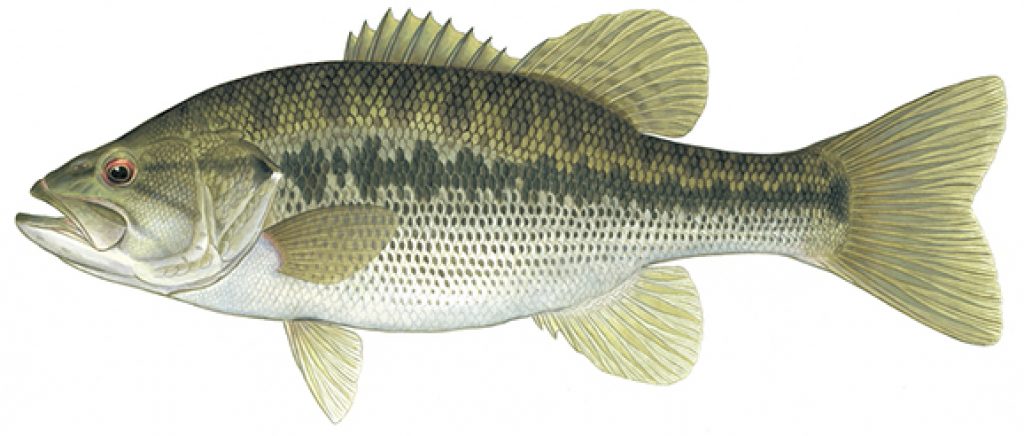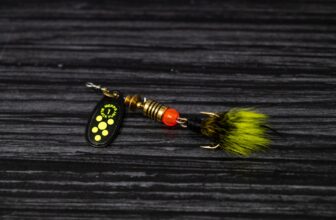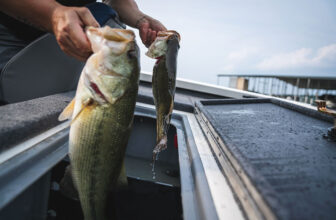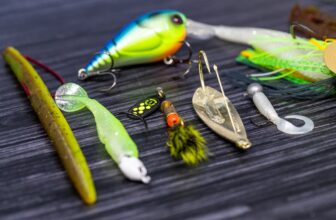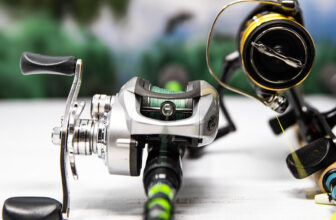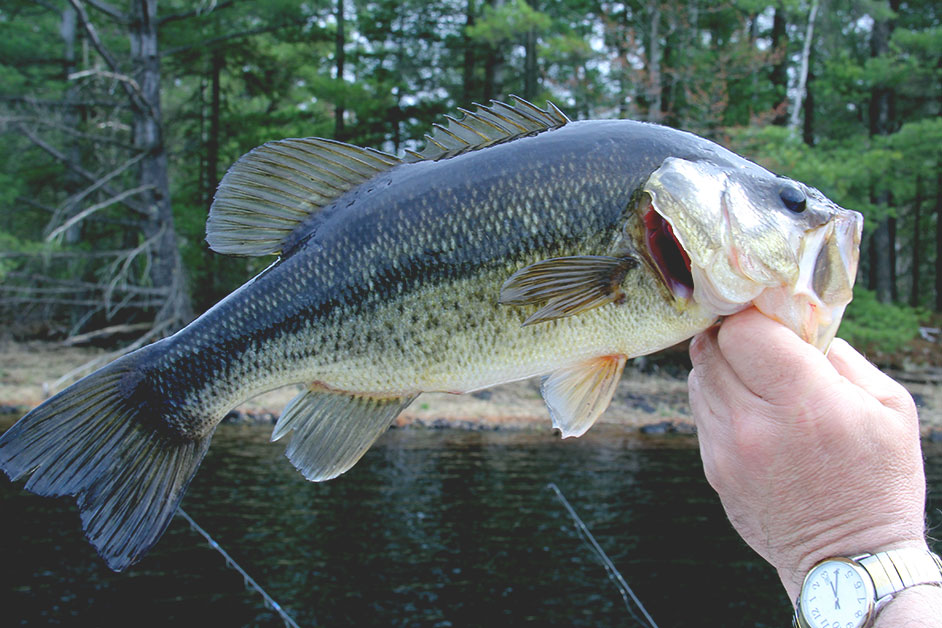
Either way you look at spotted bass vs largemouth bass, they are some of the most popular game fish an angler can chase. They are big, mean, and acrobatic. Bass are instinctive hunters and strike aggressively when they see food. That goes for just about any food. Two species of bass that are fun to pursue are spotted bass and largemouth bass. At first glance they may look like the same fish, but there are many differences.
As you start to break it down, you notice that largemouth bass have a light-colored underside with a big jaw. Spotted bass have darker coloring with spots all the way down to the belly. In this article, we will cover spotted bass vs largemouth bass and all of their differences.
Spotted Bass vs Largemouth Bass
One of the biggest differences between spotted bass and largemouth bass is where they can be found. Largemouth bass are known to stay in muddy, shallow water. They love cover as they are aggressive hunters. They are also quite lazy, so they like to sit inside the vegetation and attack as meals pass by. Spotted bass are more prone to clear water. They like structures and cover, but not necessarily vegetation.
Another difference is the metabolism between these two species. Largemouth bass tend to have a lower metabolism in cold water. This is both why they stick to warm water and why they become less active in the winter. Spotted bass maintain a high metabolism in cold and warm water, so they stay active all year.
Let’s Get Technical
To understand the differences between the spotted bass and the largemouth bass, let’s look at how they are related. Both of these species are a type of black bass. As mentioned before, they look quite similar at first glance. They have similar lateral markings and coloring.
What has created these two species is evolution based on the environments of these two fish. Bass that live in the warm waters of the South will live in a very different environment from bass that live in the lakes up North. This forces fish to adapt to their environments. It is also why there are dozens of subspecies of bass.
There are three main subspecies of spotted bass. These are the Northern, the Alabama, and the Wichita. Obviously, these fish live in the areas after which they are named. You can imagine there would be significant differences in these three different living environments. Bass originated up North and worked their way down South, so the Northern Spotted bass is the oldest variety.
The two primary types of largemouth bass are the Northern and the Florida. Florida largemouth will grow faster in the warm waters of the South, and you will notice they have smaller scales. Most of the largemouth bass we see are Northerns, so that is likely what you are used to catching.
Differences in Spotted Bass vs Largemouth Bass
Visual Cues
There are several subtle differences between the spotted bass vs the largemouth bass. As you scan the fish from nose to tail, you will start noticing some of these distinct features.
One of the biggest differences between a spotted bass and a largemouth bass is the jaw. On a spotted bass, the top jaw and bottom jaw are roughly equal in length. Largemouth bass have a larger jaw that goes past the eye on top and sticks out further on bottom.
Another big difference you may not notice at first is the tongue. The tongue on a spotted bass has a rough patch in the middle of the tongue. Largemouth bass have a smooth tongue all the way across. Just a quick glance in the mouth and you will know the difference.
The dorsal fin is the fin on top of the spine of the fish. Largemouth bass have one solid dorsal fine that does not taper down the back of the fish. On the other hand, spotted bass have a split dorsal fin. You will notice a front portion and a back portion. They are spread out and cover a larger section on the spine of the fish.
One of the most definitive ways to tell the difference between a spotted bass vs a largemouth bass is the stomach markings. Spotted bass have lines and spots that are dark in color and run laterally. They start on the side of the fish and extend down to the belly. They have very little white on their underside. Largemouth bass have a white belly that puffs out a bit.
Finally, you have the scales. There are differences in the scales on the cheeks of the fish. Largemouth bass have consistently sized scales from head to tail. The cheek scales do not change in size. Spotted bass have smaller check scales compare to the scales found on the body.
Behavioral Differences
There are some distinct differences between how a spotted bass and a largemouth bass will act once you set the hook. Largemouth bass are bigger on average and like to fight on the surface including the always exciting jump out of the water. Spotted bass are more like smallmouths in that they fight aggressively, but their first instinct is to dive deeper.
Largemouth bass love to rush the surface and launch themselves as they shake back and forth to throw the hook. Spotted bass rarely jump out of the water and will fight as deep as they can. Other behavioral differences are their social preferences. Largemouths are often loners and will spend all day hunting by themselves. Spotted bass like to stay in schools with other fish. Also, spotted bass like deep water structures like dams and bridge pillars. Largemouths like lily-pads, moss, grasses, and logs.
Where They Live
Where you might find these two different species of bass is completely different. Many people think that spotted bass can be found just about anywhere. They are actually quite finnicky about where they can thrive. You normally find them in slow moving streams and reservoirs. You generally do not find them in natural ponds and lakes. As stated before, spotted bass like clear water. That can be hard to find in natural ponds and lakes.
Largemouth bass love that warm, murky water. They love the vegetation and debris you find in these bodies of water. They can be found anywhere in the country in natural and manmade lakes, ponds, rivers, and creeks. Generally, they are prevalent in shallow waters, so shore fishing works well.
When to Catch Spotted Bass vs Smallmouth Bass
You can catch spotted bass year-round, but you will likely catch the most in the fall. During the rest of the year, spotted bass tend to move around quite a bit. In the fall, they will typically find structures in deep, cool water and stay there. This makes them much easier to locate. Dams and rocky areas are good places to start. I have the best luck with a dark colored plastic worm. For spotted bass I add some weight to be sure the lure gets deep enough.
Unlike the spotted bass, you must stick to warm seasons to catch largemouth bass. They slow down and nearly stop feeding in the fall and then pick up again in the springtime. I catch largemouth bass from March until October, but I have the best luck in April and May. Just this week I spent less than two hours at our lake and caught well over a dozen largemouth bass with half a dozen being large enough to keep. We had quite the fish fry.
Gear for Catching Spotted Bass vs Largemouth Bass
SHIMANO Rod & Reel Sienna Spinning Fishing Combo Freshwater, SN2500HGFG w/7' MH 2pc
- SN2500HGFGK/SNS70MH2B PRMT
- SN2500HGFGK/SNS70MH2B PRMT
- SN2500HGFGK/SNS70MH2B PRMT
- SN2500HGFGK/SNS70MH2B PRMT
- SN2500HGFGK/SNS70MH2B PRMT
For both of these species of fish, you can use the same rod and reel. I like a spinning rod and reel with braided or monofilament line. If it is braided, I go with a fluorocarbon leader. For plastics worms, I use a monofilament line and a leader with a dark brown worm.
You may also want to bring some backup lures in case they are not biting on plastic worms. I like to have a topwater popper with me, especially for early mornings and late evenings. I also like to have a weedless frog bait to bounce across heavy vegetation. Finally, I suggest bringing a fish finder with both a down and side view if you are not familiar with the body of water.
I hope this has helped you tell the difference between spotted bass vs largemouth bass. As you can see, there is plenty of opportunity to enjoy catching both types of fish. It really comes down to where you want to fish and when you want to fish. If you want to do some cold-water fishing, stick to clear waters and go for spotted bass. If you want to fish in the summer you can go after either, but the largemouths will be found in shallow water near vegetation. They both are tons of fun to catch, so grab your gear and get out

